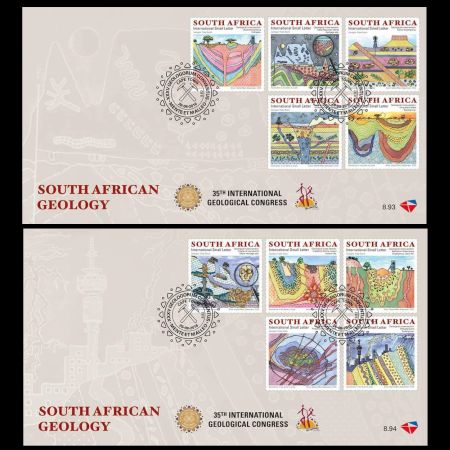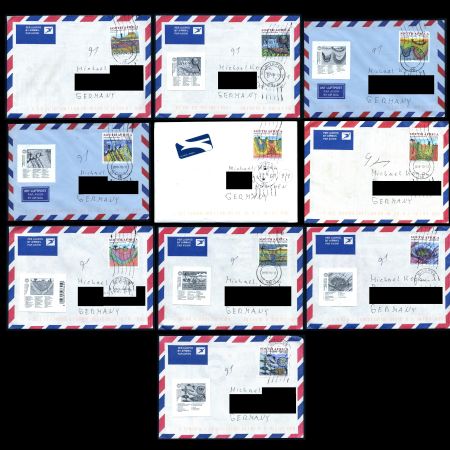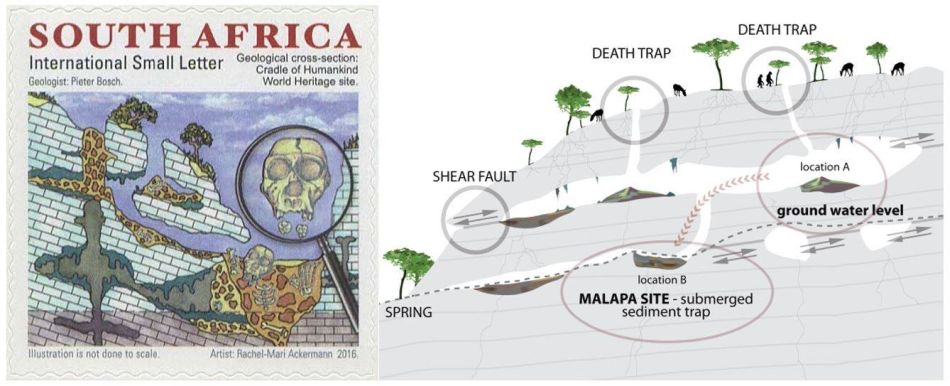Karoo Supergroup
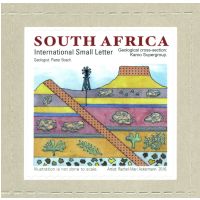 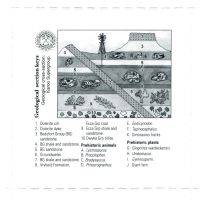
The Karoo Supergroup, a sedimentary rock
sequence, covers about two-thirds of South Africa and is several
thousand metres thick. This is the best repository in the world for
mammal-like reptile fossils, covering the transition from reptiles to
early dinosaurs and their evolution. The rocks also provide evidence of
one of the great extinction events in earth’s history about 250 million
years ago when some 90% of all life on earth disappeared. |
Barberton
Greenstone Supergroup, early life
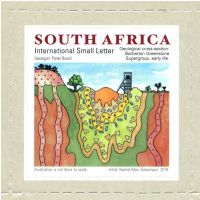 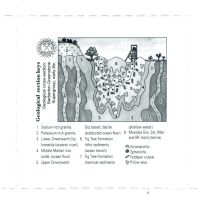
This area is located
in the east of Mpumalanga, bordering Swaziland. Remnants of the
earliest earth’s crust are preserved in the Barberton Greenstone Belt
and some of these rocks are dated at around 3,500 million years and
contain traces of very early life-forms, minute blue-green algae.
|
The
Table Mountain World Heritage Site
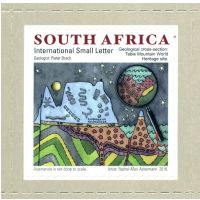 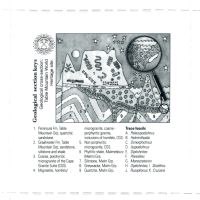
The mountain is made up
of five major rock formations, the oldest (The Malmesbury Group) is
around 700 million years old and the youngest formation is the
light-coloured quartzitic sandstone of the Table Mountain Group. Along
Chapman’s Peak, the eroded upper surface of the Cape Granite is
overlain by the lighter coloured quartzitic sandstone of the Table
Mountain Group. This geological unconformity is world famous amongst
geologists and the site along the coast at Sea Point, Cape Town, was
also visited by Charles Darwin in 1836 during his worldwide travels
with a ship named the Beagle. |
Griqualand
West Supergroup
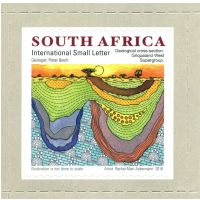 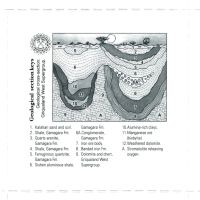
The Griqualand West Supergroup is a
pile of sedimentary rocks. These rocks formed between 2650 and 2000
million years ago when rifting and subsidence created an extensive
shallow sea in which primitive life thrived. Cyanobacteria of the area
and elsewhere released massive amounts of oxygen into the atmosphere
and it is often referred to as the oxygen pump of the earth. The
release of oxygen resulted in the chemical deposition of iron and
manganese. This Supergroup contains the world’s largest deposits of
manganese, and it is South Africa’s main iron source. |
Witwatersrand
Supergroup
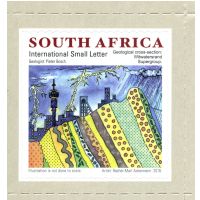 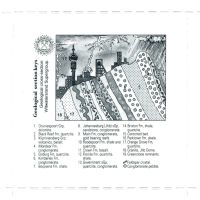
The extensive Witwatersrand gold
deposits were discovered in 1886 and it produced nearly half of the
gold ever found on earth. The Witwatersrand is the largest known
goldfield and it is distributed along a 350 km long, half-moon shaped
basin from near Evander in Mpumalanga in the east across Johannesburg
in central Gauteng towards the North-West Province near Klerksdorp and
southwards towards the central eastern Free State at Welkom. Nearly
48,000 tons of gold have been extracted from seven major mining areas. |
Vredeford
Dome meteor impact site (UNESCO World
Heritage Site)
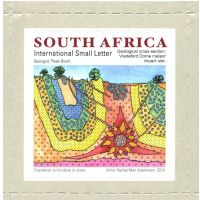 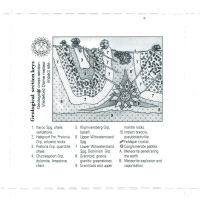
This
is the oldest known meteorite impact site in the world. A meteorite
estimated at around 10 kilometres in diameter formed an impact crater
of about 360 kilometres in diameter about 2000 million years ago
resulting in very spectacular scenery over an area of around 50
kilometres in diameter. The pressure and heat of the impact folded and
faulted some rock layers while some rocks were locally melted,
brecciated and re-solidified to form a typical impact related rock
known as pseudo-tachylite. |
Bushveld
Igneous Complex
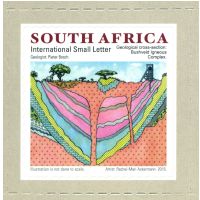 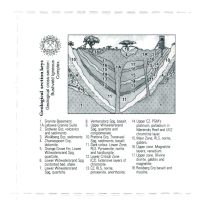
The Bushveld Complex stretches over an
area of over 65,000 square kilometres and reaches thicknesses of up to
8,000 metres. As Magma deposited 2055 million years ago, it solidified
and cooled very slowly, creating a “Layered Intrusion”; the largest of
its kind in the world. It contains the world’s largest deposits of
platinum, chrome and vanadium. |
Kimberlite
volcanic pipe
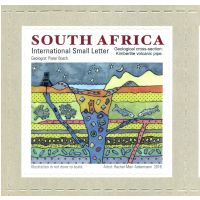 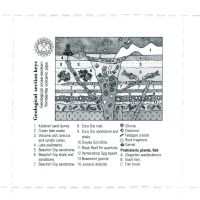
Kimberlite is the most important
primary host-rock of diamonds. Kimberlite originates very deep below
the earth’s surface, and finds its way along fissures and volcanic
pipes to the surface of the earth. Weathering and transport of the
Kimberlite and hosted diamonds gave rise to the gravels containing
diamonds along the West Coast and along the Gariep and Vaal Rivers and
their major tributaries. |
Phalaborwa
Carbonatite
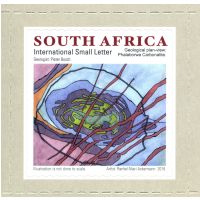 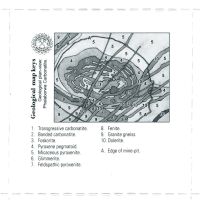
The Phalaborwa Complex is an extinct
alkaline volcanic complex that was active around 2060 million years ago
and it is the only economically viable carbonatite-hosted copper
deposit in the world. The core of the Complex, known as Loolekop is a
composite intrusion with a generally concentric arrangement of
foskorite and a core of carbonatite and dolerite. It holds South
Africa’s largest deposit of copper.
|
Cradle
of Humankind World Heritage Site
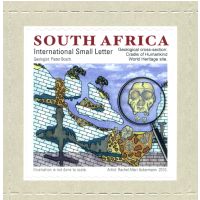 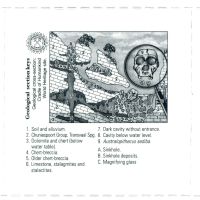
This is the most prolific
source of hominid fossils on earth. The hominids were preserved in cave
systems and karstic depressions within dolomite.
Famous hominid fossils found in the Cradle of Humankind are:
Mrs Ples”, estimated to be about 2.7 million years old,
Little Foot”, an almost complete skeleton of another hominid dated at
about 3.3 million years old.
Australopithecus Sediba, a new hominid species (depicting on the stamp),
Homo
Naledi”, the newest hominid. It is argued that the “Chamber of Stars”,
where it was discovered, might represent the first evidence of burial
by hominids. |
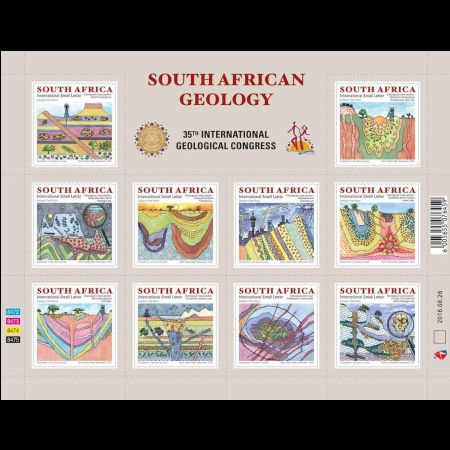
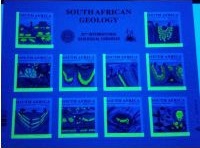 On 26 August 2016 the South African Post Office issued a
sheet of 10 International Small Letter rate stamps to coincide with the 35th
International Geological Congress at the Cape Town
International Conference Centre. The stamps offer an artistic interpretation of
ten different geological superlatives of great economic value and major
scientific importance in South Africa. Cross-sectional keys
printed on the back of the stamps. The concept designs for these stamps
were researched and drawn by South African geologist, Pieter Bosch of
the Council for Geoscience and the artwork was illustrated by artist,
Rachel-Mari Ackermann of Philatelic Services. The stamps have phosphor
spots at strategically placed areas that glow when viewed under UV
light.
On 26 August 2016 the South African Post Office issued a
sheet of 10 International Small Letter rate stamps to coincide with the 35th
International Geological Congress at the Cape Town
International Conference Centre. The stamps offer an artistic interpretation of
ten different geological superlatives of great economic value and major
scientific importance in South Africa. Cross-sectional keys
printed on the back of the stamps. The concept designs for these stamps
were researched and drawn by South African geologist, Pieter Bosch of
the Council for Geoscience and the artwork was illustrated by artist,
Rachel-Mari Ackermann of Philatelic Services. The stamps have phosphor
spots at strategically placed areas that glow when viewed under UV
light.